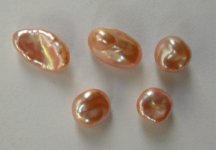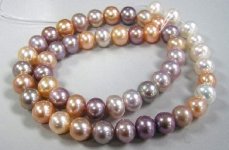D
DFrey
Guest
I have a question regarding the colors of freshwater pearls. The lot of loose baroques that I have has a predominate peachy tone and I presume is untreated. The lot of loose Keishi that I have has a predominate silver/ grey tone to it and again I am presuming that the lot is untreated. The keishi strings that I have also have a silver/ grey color to them. Both lots contain a complete range of colors that I am familar with as natural colors for freshwater, mauves, oranges, whites, pinky whites etc.
Are these peachy tones in the baroque and the silver grey for keishi the colors that whites are before bleaching? What causes the baroques to have a different overall tone than the keishi ?
Doug
Are these peachy tones in the baroque and the silver grey for keishi the colors that whites are before bleaching? What causes the baroques to have a different overall tone than the keishi ?
Doug



